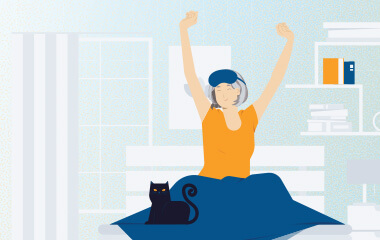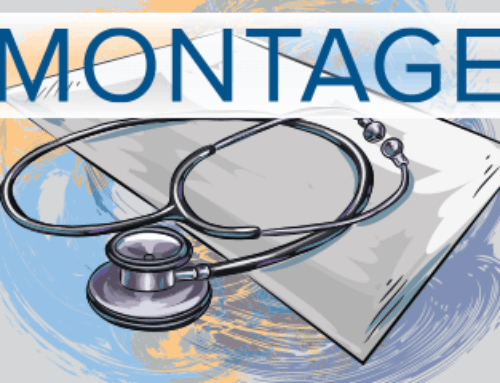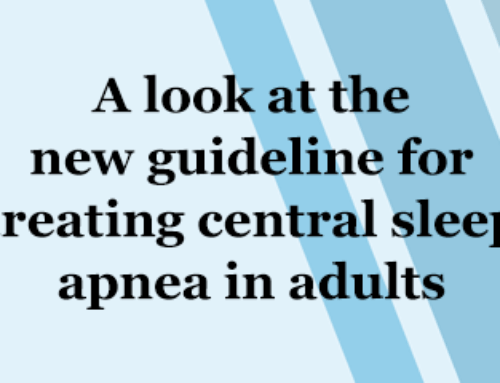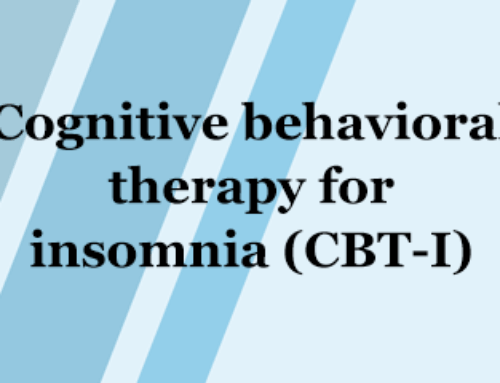By Monica Prasad Mallampalli, PhD
There is enough scientific evidence to support the fact that women’s sleep is different than men’s. For example, women tend to have shorter sleep duration, more slow wave sleep and longer sleep latency compared with men. Sleep in women can vary across the lifespan, and several factors at specific timepoints — such as puberty, pregnancy or menopause — can influence sleep quality. These factors can be biological and physiological, but environmental, cultural, social and other factors also can influence a woman’s sleep health.
Certain sleep disorders, like insomnia, circadian rhythm sleep-wake disorders and restless legs syndrome (RLS), are more prevalent in women. The risk for insomnia emerges at puberty with the onset of menses and, interestingly, depression risk coincides with insomnia in this time period. Shift work disorder is more common in women partly due to differences in work patterns: More women tend to work non-traditional hours compared with men. Shift work in women also can increase the risk of breast and endometrial cancer, and almost 70% of women with breast cancer have poor sleep problems. RLS risk increases two-fold from pregnancy to menopause and increases with the number of pregnancies.
Sleep differences between the sexes, including differences in how sleep problems present, can contribute to missed diagnoses. Narcolepsy and obstructive sleep apnea (OSA) diagnoses are often delayed or missed in women. Women with narcolepsy bear a greater disease burden than men, with lower health-related quality of life and more sleepiness. OSA also presents differently in women compared with men, with women complaining of more fatigue, unrefreshing sleep, depression and insomnia. The lack of sex-specific screening instruments is a major problem leading to underdiagnosis of OSA in women.
The follow-on effects from these diagnostic problems are important to consider. Women with sleep disorders are at an increased risk for cardiovascular and metabolic diseases. Untreated sleep apnea in women can increase the risk of heart failure in women and mortality compared with men. Similarly, sleep problems are common with people living with chronic pain. In fact, insomnia can both result from and contribute to chronic pain — and both conditions disproportionately affect women.
Women’s sleep problems go unnoticed partly due to a lack of awareness among women and their physicians. Sometimes women get misdiagnosed with anxiety or depression; both conditions are often co-morbid with sleep disorders. A paucity of sex-specific screening questionnaires or diagnostic tools in a one-size-fits-all approach to treatment also can make it harder for women to get an appropriate diagnosis and the care they need.
These kinds of health care gaps don’t only affect women in sleep medicine but also exist to varying degrees in other medical specialties, thanks to certain scientific and policy decisions made decades ago.
It has only been 32 years since women have been included in biomedical research, and this exclusion of females in biomedical research has compromised the health of females to this day. Given that almost all biomedical research previously has used a 70-kg male as the standard to study human health, females have lacked appropriate medical care for years. Basically all information related to female-specific biology, anatomy, pathology and response to interventions had been disregarded under the assumption that females only differed from males in their reproductive health.
This decision to ignore female biology was based on a guidance issued by the Food and Drug Administration in 1977, which suggested barring women of child-bearing potential from participating in early phases of clinical trials out of fear of harming the unborn children. The decision came not long after birth defects caused by thalidomide and diethylstilbestrol (DES), a synthetic estrogen, had raised acute concerns about the safety of drug trials during pregnancy.
However, the 1985 Public Health Services Task Force on Women’s Health concluded that the dearth of research on women’s health had compromised quality of information and care for women. This prompted women’s health advocates to push for inclusion of women and minorities in clinical trials, resulting in the passage of the 1993 NIH Revitalization Act by Congress.
We now know unequivocally, based on a volume of scientific evidence and data, that the health of females extends beyond their reproductive health or capabilities and takes into account all diseases and conditions that affect a woman from head to toe.
Similarly, we have seen a sharp rise in scientific publications on the topic of women and sleep in the last decade. We have also witnessed efforts at the organizational level to advance women’s sleep health, such as those led by the Sleep Network at the Society for Women’s Health Research (2013-2017), the National Institutes of Health Research Conference on Sleep and Health of Women in 2018, and, most recently, the launch of the Advancing Women’s Sleep Health Task Force by the American Academy of Sleep Medicine in 2025. At the Alliance of Sleep Apnea Partners, we too are bringing attention to women’s sleep health — and providing tools to help women advocate for their own health. Our educational resources encourage women to seek diagnosis and care if they suspect they have OSA symptoms.
Today, women make up half the population in the United States and spend twice as much time caring for family members compared with men. More importantly, women play a major role in health care decisions for themselves and their families, essentially serving as the chief medical officer of their home. As the share of women in our workforce has grown, so has their insurance coverage: 39 million women aged 18-64 have employment-based coverage of their own, with 29 million women receiving coverage from the private sector. But women are yet to achieve health equity and the opportunity to be as healthy as possible on a par with their male counterparts.
According to a 2024 national poll, women are getting less sleep than they need. Stress is the primary driver of the decline in their sleep quality. Poor sleep and increased stress can have a substantial impact on women’s overall health, even beyond the existing inequities. As members of the sleep community, we can do our part to eliminate some of these disparities and advance women’s sleep health. Together we can:
- Empower women through education and awareness to take an active role in their health and ensure they get quality sleep.
- Ensure that sleep professionals are aware of women-specific health issues and concerns.
- Enable sleep researchers to take biological sex into account when designing clinical studies and to analyze data and report results based on sex.
- Encourage the sleep industry to consider a personalized approach to diagnostics and treatment by evaluating safety and efficacy of interventions in women and men separately.
Acknowledging that women experience care gaps is the first step. We can all now focus on the real work of bridging the gap, one brick at a time, from understanding the effects of sex hormones on the brain to solving access challenges. We must not rest until we remove all the health disparities that prevent women from receiving quality health care and quality sleep.
Monica Prasad Mallampalli, PhD, is a subject matter expert on women’s health and chief executive officer at the Alliance of Sleep Apnea Partners, a national nonprofit patient advocacy organization. She is a member of the AASM Advancing Women’s Sleep Health Task Force.
References
- Mallampalli MP, Carter CL. Exploring sex and gender differences in sleep health: a Society for Women’s Health Research Report. J Womens Health (Larchmt). 2014;23(7):553-562.
- Pengo MF, Won CH, Bourjeily G. Sleep in women across the life span. Chest. 2018;154(1):196-206.
- Pajėdienė E, Urbonavičiūtė V, Ramanauskaitė V, Strazdauskas L, Stefani A. Sex differences in insomnia and circadian rhythm disorders: a systematic review. Medicina (Kaunas). 2024;60(3):474.
- Seeman MV. Why are women prone to restless legs syndrome? Int J Environ Res Public Health. 2020;17(1):368.
- Sack RL, Auckley D, Auger RR, et al. Circadian rhythm sleep disorders: part I, basic principles, shift work and jet lag disorders. An American Academy of Sleep Medicine review. Sleep. 2007;30(11):1460-1483.
- Barker EC, Flygare J, Paruthi S, Sharkey KM. Living with narcolepsy: current management strategies, future prospects, and overlooked real-life concerns. Nat Sci Sleep. 2020;12:453-466.
- Mallampalli MP, Carter CL. Exploring sex and gender differences in sleep health: a Society for Women’s Health Research Report. J Womens Health (Larchmt). 2014;23(7):553-562.
- Women and Sleep Guide. Society for Women’s Health Research. https://swhr.org/wp-content/uploads/2024/03/SWHR_Women-Sleep-Guide.11.2017.pdf. 2017. Accessed February 14, 2025.
- Torgrimson BN, Minson CT. Sex and gender: what is the difference?. J Appl Physiol (1985). 2005;99(3):785-787.
- General Considerations for the Clinical Evaluation of Drugs. Food and Drug Administration. https://www.fda.gov/media/71495/download.
- Women’s health. Report of the Public Health Service Task Force on Women’s Health Issues. Public Health Rep. 1985;100(1):73-106.
- 1 – National Health Security Act of 1993. https://www.govtrack.us/congress/bills/103/s1.
- QuickFacts: United States. United States Census Bureau. https://www.census.gov/quickfacts/fact/table/US/LFE046223.
- Women and Job-Based Health Insurance. U.S. Department of Labor. https://www.dol.gov/agencies/ebsa/about-ebsa/our-activities/resource-center/fact-sheets/women-and-job-based-health.
- Women and Job-Based Health Insurance. U.S. Department of Labor. https://www.dol.gov/agencies/ebsa/about-ebsa/our-activities/resource-center/fact-sheets/women-and-job-based-health.
- Americans Sleeping Less, More Stressed. Gallup Wellbeing. https://news.gallup.com/poll/642704/americans-sleeping-less-stressed.aspx. April 15, 2024.





